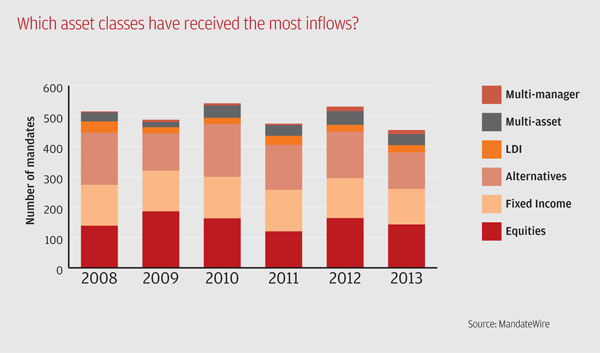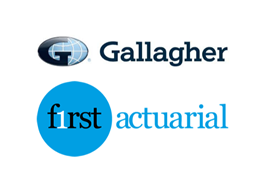Strong performance in equity markets has seen a surge in schemes awarding mandates to the asset class, but it’s not homegrown equities that are piquing the interest of investors.
For the full The Specialist report on investment trends, click here to download the PDF
Some plans are moving into riskier assets such as equities to gain extra return, and others are derisking, investment data show.
Recent strong performance in equity markets has led some schemes to reconsider the asset class. Data from schemes surveyed by Financial Times service MandateWire show an increase in the number of mandates awarded to equities in 2012 and 2013 (see graph).

There were 164 awarded mandates, including the reweighting of assets, in 2012. This is compared with 120 mandates in 2011. And the trend looks set to continue, with 143 mandates awarded to equities in the first three quarters of 2013.
Rethinking equities
Investors are tilting their equity portfolios towards non-traditional strategies. The data show a continuous decrease in the number of mandates awarded to UK equities (see graph opposite) since 2009, with just eight recorded in 2012.
Global equities have been the primary benefactor, with 98 awarded mandates last year. Emerging market equities also proved a popular choice among schemes, with 31 recorded instances of inflows in 2012 and 38 in 2013 so far.
Over the next five to 10 years the average return for emerging markets will be higher than in developed markets, says Steve White, managing director at Buck Global Investment Advisors.
There has also been a move away from passive management into “less benchmark aware” active management, particularly in emerging market and global portfolios. “Selecting equities from all around the world with a bottom-up approach… rather than on a regional allocation [basis] has been attractive,” he says.
Schemes are looking to lock in growth with exciting asset classes such as emerging market and African equities, says Jonathan Seed, director at consultancy Xafinity.
“Last year was a great year for [being] invested in equities,” he says.
But he warns that DB schemes need to have one eye on their liabilities when they are investing. “[Schemes] can’t afford to have too much money tied up in long-term volatile assets,” he adds.
Another major trend has been the diversification of fixed income portfolios. Expensive bonds and low yields are forcing schemes to look at different sources of return.
“We are seeing some thought to considering bonds not just as a derisking mechanism but also as an alpha-generating mechanism, such as unconstrained absolute return strategies,” says Terry Mellish, head of UK and Ireland business and global consultant relationships at Natixis Global Asset Management.
Schemes have been diversifying up the fixed income risk curve into products such as senior secured loans and multi-asset credit.
“We like products like absolute return bonds because it is about finding that talented bond manager and giving them maximum freedom to go anywhere to find the answer, and it takes out the duration,” said John Belgrove, partner at consultancy Aon Hewitt.
Alternative investments were also popular with schemes, with real assets garnering the most interest. The data show property was a clear favourite, with 54 mandates awarded to the asset class since the start of this year and 57 in 2012. This is compared with 46 in 2011.
Infrastructure also gained traction in 2012 with 22 instances of inflows. This was up from 16 in 2011.
“There is an increased interest in more illiquid assets from a minority of pension funds [that have] long time horizons and are happy to lock up investments for five, 10 or 15 years,” says White.
He adds that schemes with strong company covenants are willing to invest in closed-end vehicles such as private equity, infrastructure or real estate debt to capture illiquidity premia.
Interest in hedge funds and private equity has fallen off, with the two strategies seeing big inflow drops to hedge funds. MandateWire recorded 22 mandates awarded by schemes in 2012 and 15 in 2013, compared with a high of 46 in 2010.
Private equity suffered a similar fate, with inflows of just 15 mandates in 2012, down from a high of 29 in 2008.
The use of multi-asset funds also increased, with 36 mandates recorded already in 2013 and 45 in 2012.
Matching liabilities
Even though rerisking is back on the table, many schemes are taking the opportunity to hedge liabilities, as well as inflation and interest rates.
Liability-driven investment awards have been consistent since 2008, according to MandateWire data. However, with 24 awards recorded already in 2013 (see graph), compared with 22 in all of 2012, this could point to schemes looking to take advantage of rising gilt yields.

The path towards derisking has accelerated over the past year, says White. “We have an increased acceptance of movement to protect pension schemes against interest rate and inflation risk, and for that to be done on a dynamic basis,” he says.
Schemes are putting in place trigger points for inflation or interest rates which will activate a move from a traditional bond portfolio to an LDI approach.
The data also show a marked increase in the number of fiduciary management mandates awarded, which could point to further derisking.
For the full The Specialist report on investment trends, click here to download the PDF
Xafinity’s Seed expects fiduciary management to grow rapidly in the coming years as trustees look to pass the investment governance and implementation burden to someone else.
“The challenge is finding someone that is genuinely independent, because if you are giving your money to an asset manager they will be investing it in their own funds, not looking around the market,” he says.






















